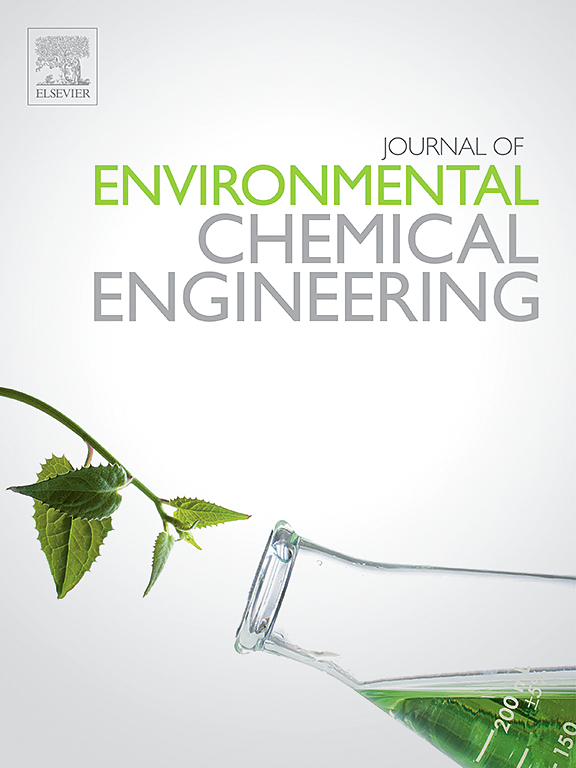通过同位素追踪法分析路边土壤中的铅污染源
IF 7.2
2区 工程技术
Q1 ENGINEERING, CHEMICAL
引用次数: 0
摘要
除工业污染源外,道路交通污染源正成为土壤中潜在有毒元素(PTEs)污染的主要来源。运输过程中产生的 PTEs 污染物主要包括铅(Pb)和其他元素。为了明确路边大气和土壤中铅的来源及其相对贡献,本研究在工业区和非工业区采集了路边大气降尘、沉积物和土壤样品,并通过电感耦合质谱法(ICPMS)测定了样品中铅的同位素值。通过同位素追踪,对路边大气和土壤样本中的铅来源进行了量化。结果表明,车辆排放物对路边大气中的铅贡献最大,其次是道路沉积物和自然降尘,贡献率分别为 43.5% 至 48.9%、35.3% 至 39.8%、15.8% 至 16.7%。路边降尘对路边土壤中铅的影响最大,其次是道路沉积物。在这些来源中,路边降尘和道路沉积物在非工业区分别占 68.3-68.4% 和 31.6-31.7%,在工业区分别占 61.2-61.3% 和 38.7-38.8%。该研究结果为预防和控制路边土壤中的铅污染提供了依据。本文章由计算机程序翻译,如有差异,请以英文原文为准。
Analysis of lead contamination sources in roadside soil via the isotope tracing method
In addition to industrial contamination sources, road traffic sources are becoming major sources of potentially toxic elements (PTEs) contamination in soil. The PTEs contaminants generated during transport mainly include lead (Pb) and other elements. In this study, to clarify the sources of Pb in the roadside atmosphere and soil and their relative contributions, roadside atmospheric dustfall, sediment and soil samples were collected in industrial and nonindustrial areas, and the Pb isotope values of the samples were determined via inductively coupled plasma![]() mass spectrometry (ICP
mass spectrometry (ICP![]() MS). The sources of Pb in the roadside atmosphere and soil samples were quantified via isotope tracing. The results revealed that vehicle emissions contributed the most to Pb in the roadside atmosphere, followed by road sediment and natural atmospheric dustfall, with contributions ranging from 43.5 % to 48.9 %, 35.3–39.8 %, and 15.8–16.7 %, respectively. Roadside atmospheric dustfall contributed the most to Pb in roadside soil, followed by road sediment. Among these sources, roadside atmospheric dustfall and road sediment contributed 68.3–68.4 % and 31.6–31.7 %, respectively, in nonindustrial areas and 61.2–61.3 % and 38.7–38.8 %, respectively, in industrial areas. The results of this study provide a basis for preventing and controlling Pb pollution in roadside soils.
MS). The sources of Pb in the roadside atmosphere and soil samples were quantified via isotope tracing. The results revealed that vehicle emissions contributed the most to Pb in the roadside atmosphere, followed by road sediment and natural atmospheric dustfall, with contributions ranging from 43.5 % to 48.9 %, 35.3–39.8 %, and 15.8–16.7 %, respectively. Roadside atmospheric dustfall contributed the most to Pb in roadside soil, followed by road sediment. Among these sources, roadside atmospheric dustfall and road sediment contributed 68.3–68.4 % and 31.6–31.7 %, respectively, in nonindustrial areas and 61.2–61.3 % and 38.7–38.8 %, respectively, in industrial areas. The results of this study provide a basis for preventing and controlling Pb pollution in roadside soils.
求助全文
通过发布文献求助,成功后即可免费获取论文全文。
去求助
来源期刊

Journal of Environmental Chemical Engineering
Environmental Science-Pollution
CiteScore
11.40
自引率
6.50%
发文量
2017
审稿时长
27 days
期刊介绍:
The Journal of Environmental Chemical Engineering (JECE) serves as a platform for the dissemination of original and innovative research focusing on the advancement of environmentally-friendly, sustainable technologies. JECE emphasizes the transition towards a carbon-neutral circular economy and a self-sufficient bio-based economy. Topics covered include soil, water, wastewater, and air decontamination; pollution monitoring, prevention, and control; advanced analytics, sensors, impact and risk assessment methodologies in environmental chemical engineering; resource recovery (water, nutrients, materials, energy); industrial ecology; valorization of waste streams; waste management (including e-waste); climate-water-energy-food nexus; novel materials for environmental, chemical, and energy applications; sustainability and environmental safety; water digitalization, water data science, and machine learning; process integration and intensification; recent developments in green chemistry for synthesis, catalysis, and energy; and original research on contaminants of emerging concern, persistent chemicals, and priority substances, including microplastics, nanoplastics, nanomaterials, micropollutants, antimicrobial resistance genes, and emerging pathogens (viruses, bacteria, parasites) of environmental significance.
 求助内容:
求助内容: 应助结果提醒方式:
应助结果提醒方式:


